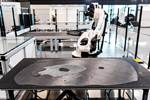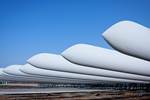Siemens Gamesa, Airborne collaborate on automation of wind turbine blades
Joint efforts combine years of expertise in the manufacture of wind turbine blades, composite processing and automation to scale up operations.
Photo Credit: Siemens Gamesa Renewable Energy
(SGRE, Zamudio, Spain) has contracted Airborne (The Hague, Netherlands) to engineer and supply an automated system for the manufacturing of composite offshore wind turbine blades.
By working together, both companies bring years of expertise in the manufacture of wind turbine blades, composite processing and automation to make this project a success. Airborne is a 100% composites-focused digital automation company with more than 25 years of experience in developing composite solutions for high-tech industries such as aerospace, automotive and renewable energy. Siemens Gamesa supplies wind turbines globally with what it says is unique process for manufacturing large offshore blades.
“We are excited to support Siemens Gamesa in this challenging project,” Marcus Kremers, CTO of Airborne, notes. “The scale of the operation is impressive and the requirements on layup rate are higher than we have ever seen. We are proud to bring our technologies and expertise to the table and jointly develop the right technology.”
Morten Westeraa, robotics expert of Siemens Gamesa agrees, finding potential and demand in the global wind turbine market. “It is essential that our production is kept at the highest level of efficiency, throughput and quality,” Westeraa adds. “We are confident that Airborne is a very skilled partner on this journey.”
Related Content
-
SAM XL demonstrates closed-loop digital methodologies via full-size aerocomposite parts development
PeneloPe Project’s modular, zero-defect manufacturing deliverables are being highlighted in an upcoming video that demonstrates the resulting aerospace pilot line’s feasibility.
-
UniSQ, iLAuNCH Trailblazer program drive digital twin innovation for composite repairs
Working with Boeing Australia, Memko and Dassault Systèmes, the University of Southern Queensland (UniSQ) has developed a digital twin via the 3DEXPERIENCE platform, digitizing processes that could lead toward more efficient and effective maintenance, repair and operations of future fleets.
-
Schrödinger advances materials informatics for faster development of next-gen composites
Cutting time to market by multiple orders of magnitude, machine learning and physics-based approaches are combined to open new possibilities for innovations in biomaterials, fire-resistant composites, space applications, hydrogen tanks and more.



